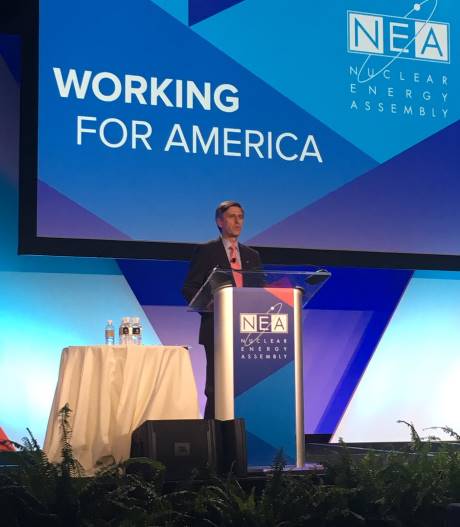Westinghouse aims for competitive future
25 May 2017
Westinghouse's core business remains strong and the company intends to emerge from Chapter 11 bankruptcy stronger, better and more competitive, interim president and CEO José Gutíerrez said yesterday.
 |
| Gutiérrez addresses the Nuclear Energy Assembly in Scottsdale, Arizona (Image: NEI) |
Gutiérrez's speech to the Nuclear Energy Assembly - the US Nuclear Energy Institute's (NEI's) annual conference for the US nuclear industry, held this week in Arizona - was his first discussion of Westinghouse's current situation in an open forum since the company's 29 March bankruptcy filing. He said it was important to note that the filing focuses on the construction of the four US reactors at Vogtle and VC Summer. The company's AP1000 construction projects in China are making good progress, and the company remains confident that AP1000 is "good technology," he said.
The bankruptcy filing was a strategic move to "reset the financial footprint" of the company to address construction issues at US projects, while protecting the company's core business, he said. The projects have been beset by significant cost overruns.
The two AP1000s being built at Vogtle in Georgia are scheduled for commercial operation in December 2019 and September 2020, respectively. The project is majority owned by Georgia Power (45.7%), with co-owners Oglethorpe Power (30%), MEAG Power (22.7%) and Dalton City (1.6%), and the units will be operated by Southern Nuclear Operating Company. The two units under construction at VC Summer in South Carolina are being built for Scana subsidiary South Carolina Electricity and Gas and co-owner Santee Cooper and are currently expected to begin operation in 2020.
Gutíerrez said a combination of factors had led to the issues prompting the bankruptcy declaration. The original contracts were signed in 2008 in the context of an expected "nuclear renaissance" - with up to 32 reactors under construction or contracted by 2030 - which failed to materialise. The company had to make significant redesigns to the reactors in response to requirements from the US Nuclear Regulatory Commission after the September 2001 terrorist attacks and the 2011 Fukushima accident.
He also said the company - and the wider nuclear industry - did not anticipate the challenges and issues associated with a resumption of nuclear new-build in the USA 30 years after the country's last reactor construction project. "A lack of appropriate infrastructure, knowledge and experience became a reality," he said, citing the challenges of rebuilding the supply chain.
Westinghouse's relationship with contractor Stone & Webster had not worked as well as envisioned, he said, eventually leading to the 2015 strategic decision to buy Stone & Webster from Chicago Bridge & Iron Company. Westinghouse parent Toshiba announced in December 2016 that it may have to write off "several billion" dollars because of Westinghouse's purchase of the construction firm.
Strong core
Away from the US construction projects, Gutíerrez said the company was "very stable". While working with the owners of Vogtle and VC Summer to find a long-term solution to complete the reactors, the rest of Westinghouse's business remained strong. Since the bankruptcy filing, Westinghouse has been awarded several fuel contracts, which Gutíerrez said demonstrated customers' confidence in the future of the company.
Westinghouse remains committed to its reactor design business and will pursue future sales, Gutíerrez said, noting future opportunities in China, India, Turkey and the UK. The company is working to develop a "more achievable delivery model" to reduce risk, he said, adding that future projects would adopt an approach more like that used in China, where four AP1000s are under construction at Sanmen and Haiyang. Fuel loading is expected to begin this summer at Sanmen 1 and Haiyang 1.
Gutíerrez's speech was live-streamed on Facebook by NEI.
Researched and written
by World Nuclear News